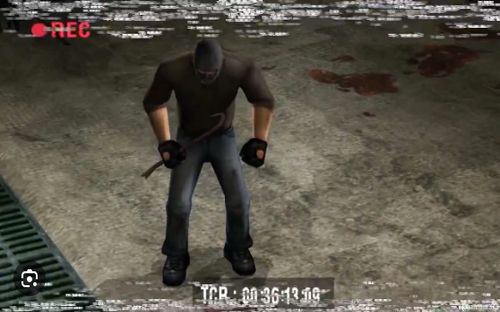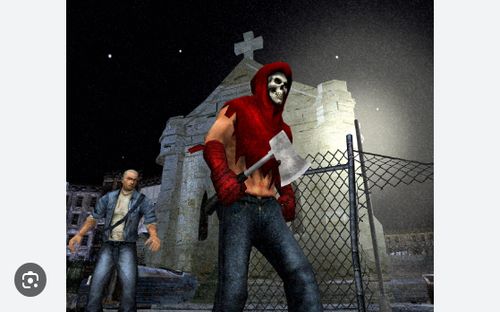The 2003 video game “Manhunt,” which was made by Rockstar North, is among the most contentious ever made. The protagonist of the game is James Earl Cash, a death row convict whose execution is staged by an enigmatic figure known only as “The Director,” forcing him to take part in a cruel series of snuff videos. The game, which is set in the made-up city of Carcer, delves into the most sinister corners of human cruelty and depravity, putting players in ethically dubious situations where survival depends on cunning and violence. Manhunt pushes the boundaries of what is appropriate for interactive media by establishing a depressing, nihilistic tone in the opening segment and maintaining it throughout the entire film.
Manhunt lacks a vast plot with numerous nuanced characters and an expansive universe, in contrast to many of its peers. Rather, the gameplay is entirely centered around stealth-based murder and survival. Enemies, who are members of hideous gangs, wander and hunt in the gloomy, restricted settings that players must traverse. Initially armed with commonplace items like plastic bags and broken glass, Cash is supposed to kill enemies in a disgusting and silent manner. Players are rewarded for being as nasty as they can be because the more inventive and vicious the death, the higher the score. In addition to being essential to gameplay, this mechanism serves as the experience’s central theme, forcing the player to face the act of murdering head-on in a straightforward and unapologetic way.

Manhunt’s aesthetically pleasing design supports its unsettling idea. Visually, it resembles the shaky, low-quality video found on vintage VHS cassettes, complete with distortion and flickers that imply the existence of a covert, voyeuristic camera. The settings are bleak and abandoned, with rusty fences, graffiti-covered buildings, flickering neon signs, and urban degradation. As if the player is always being seen, assessed, and controlled, this breeds anxiety and stress. A sensation of being imprisoned in a nightmare turned real is enhanced by the sound design, which includes ambient noise, eerie music, and the guttural cries of opponents.
The storyline of Manhunt is simple yet powerful; it only connects the game’s increasingly violent stages. The Director taunts and exhorts Cash to engage in further violence with his incessant remarks over his headset, serving as both a narrative guide and a tormentor. This persona frequently blurs the distinction between a deity figure and a filmmaker, serving as a critique of voyeurism, entertainment, and domination. The player grows increasingly indifferent to the brutality as the narrative goes on, reflecting Cash’s own decline into moral numbness. Players are forced to view Cash’s journey more as a psychological unraveling than a story of redemption due to the absence of conventional heroics and the scant explication.
As expected, the public’s response to Manhunt was explosive. Its severe brutality was denounced by both politicians and others, with some claiming it was only a murder simulator. The game was highlighted in a real-life criminal case in the UK, where it was controversially connected to the death of a teenager, and it was banned in a number of other nations. Rockstar defended the game as an artistic expression, claiming that its themes were purposefully unsettling and that it was intended for older consumers. The game’s popularity only grew as a result of the controversy, which also made it a central topic in discussions concerning video game violence and its possible behavioral effects.
Several segments of the game industry praised Manhunt in spite of the criticism. Its inventive stealth techniques and eagerness to push limits were recognized by certain commentators. The game was seen as a daring, albeit unsettling, experiment using mood and mechanics to convey a tale. Few could dispute that the game had a clear vision and a unique personality, even though many people found the material offensive. Few developers would dare take such chances, particularly for a commercial product supported by a large publisher. The emergence of Manhunt questioned accepted conventions in the business and created room for more sophisticated, contentious game narratives.



The actual stealth gaming is meticulous and tense. Players need to pay close attention to audible cues, timing their moves precisely, and disguise themselves by using shadows. Depending on how long the player presses the assault button when ambushing an adversary, the execution mechanism is tier-based into three levels: rapid, violent, and horrible. In addition to rewarding perseverance and preparation, this approach encourages the player to get more fully immersed in the macabre aspects of the actions being done. Manhunt’s fighting is seldom empowering, in contrast to other action-packed titles. It emphasizes that violence is never simple or tidy and is clumsy, sluggish, and nerve-racking.
System Requirements OF Manhunt 1 Highly Compressed PC
| Ram | 512 MB RAM |
|---|---|
| Processor | Pentium III 800 MHz |
| Accessories | Keyboard, mouse, and speaker |
| Graphics card | GeForce FX 5700 |
| Windows | Xp, 7, 8, 8.1, 10, and 11 |
| Free disk space | 2.3 GB |
The game’s layout is largely linear, with each level acting as a set for a movie, which highlights the director’s control over the plot. Players are acting out the violence for an invisible audience in addition to taking part in it. The player is implicated in the spectacle by this theatrical framing, which raises troubling concerns regarding the consumption of violent media. Why do humans find amusement in suffering? When we take pleasure in the ideal stealth kill, what does it reveal about us? Although Manhunt doesn’t provide answers, it compels us to consider such issues regardless of our desire to do so.
Manhunt’s remark on societal deterioration and the exclusion of the urban poor is one of its more underappreciated features. Carcer City is a nightmare of institutional degradation, chaotic streets, and malfunctioning infrastructure. The gangs that Cash has to avoid or destroy are not parodies; rather, they are heightened depictions of the craziness and despair that exist in the actual world. The scene serves as more than simply a background for violence; it also serves as a metaphor for what society may turn into when lawlessness reigns and cruelty is encouraged. The game’s setting of players in such a setting depicts a cynical worldview in which sacrificing one’s humanity is frequently necessary for survival.
Manhunt is ultimately not a game for everyone, and it never was. It delves unapologetically into the worst tendencies of its players and characters. It questions the idea that video games are just for amusement by leveraging its plot and mechanics to elicit discomfort, introspection, and even disgust. Manhunt is still one of the most distinctive and memorable games of its time, regardless of whether it is seen as a daring creative statement or an exercise in tasteless shock value. Its legacy endures twenty years later, not because it was adored but more because it dared to question whether we truly know what we’re doing when we hit the death button.


